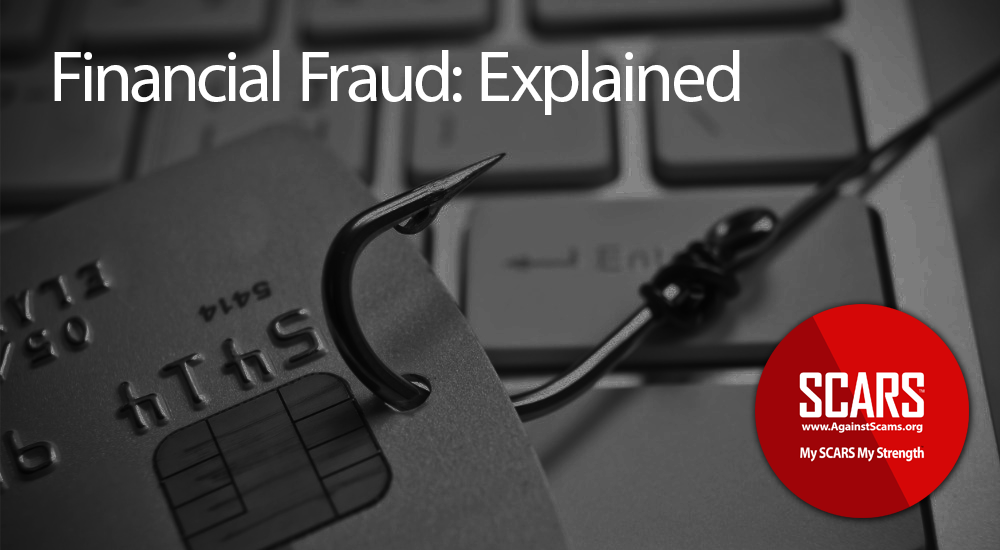Financial Fraud: Explained
A SCARS Guide Based Upon FINRA Information
2020 Edition
All fraud uses deception to enrich the fraudsters. In the case of financial fraud, deception and misrepresentation are used in conjunction with financial products, investments, or personal assets such as a house.
While financial fraud encompasses a wide range of illegal behavior, our focus is on frauds that primarily target individuals: Ponzi schemes, mortgage fraud, advance-fee schemes, relationship scams, and credit card theft are all-too-common examples.
Definitions:
In this article we are going to use certain terms interchangeably. Fraud is the same as Scam. Fraudster is the same as Scammer.
Basics
While the actual fraud varies, a similar set of tactics is used to separate victims from their money, including:
- gaining victims’ trust and confidence to gain money;
- using false information to induce victims to invest in or purchase products that don’t exist; or
- stealing identifying information.
A BIG PROBLEM
Obtaining an accurate estimate of fraud prevalence has been hindered by a number of factors. Estimates vary, sometimes widely, due to inconsistent definitions of fraud, differences in the types of fraud examined and the populations studied, underreporting of fraud, and the method used to measure fraud, such as law enforcement records or surveys. Prevalence estimates need to be considered in this context.
11-15% of U.S. Population Have Reported*
Recent studies estimate that between 11 and 15 percent of the population are self-reported victims of financial fraud. A Federal Trade Commission report from 2013 estimated 25.6 million people were victims of one or more of the financial frauds included in the survey during 2011. And a 2012 survey by the FINRA Foundation found that more than 8 in 10 respondents were solicited to participate in a potentially fraudulent offer, with 11 percent of all respondents losing a significant amount of money after engaging with an offer.
8 out of 10 Scammed!
Regardless of the varying prevalence rates, these and other studies conclude that financial fraud is a significant and costly problem. The Financial Fraud Research Center—a joint project of the Stanford Center on Longevity and the FINRA Foundation—estimated the financial cost of consumer scams in the U.S. to be nearly $50 billion per year.
* SCARS NOTE: Since ONLY 3-5% of victims report these crimes, the actual number is probably 20 times (20x) what is estimated by the government since they only estimate based upon report numbers. Thus if they estimate US$50 billion x 20 = US$1 TRILLION DOLLARS. That number is much closer to the industry estimates of US$3 trillion dollars annual losses now.
These Numbers Are Likely The Tip Of The Iceberg
Experts in the field are well aware that financial fraud is largely underreported. Reporting one’s victimization is complicated by feelings of shame and guilt, as well as other complex factors, such as:
- not knowing where to turn;
- feeling that reporting wouldn’t make a difference;
- fear that reporting will lead to a loss of legal or financial control;
- threats and intimidation from the perpetrators;
- loss of esteem or prestige in a victim’s social group;
- concern that reporting may culminate in a family member or friend being arrested or sent to prison, which is particularly concerning if the individual is dependent on the exploiter; and
- lack of confidence in the ability of authorities to respond and assist.
One valuable contribution victim advocates can make to the cause of fighting financial fraud is to encourage victims to report the crime. Advocates can help victims overcome the stigma of being “taken” by a fraudster. They can sympathize with what has happened but also emphasize the value of taking action—including reporting the crime to the proper authorities.
HOW FRAUD HAPPENS
SCARS NOTE: You are not alone. Millions of people are defrauded every year. And you are a target only because you have money and assets to steal—not because of a failing on your part.
We’ve all heard the timeless admonition: “If it sounds too good to be true, it probably is.” But fraudsters make their living by making sure the deals they tout appear both good and true. The trick is figuring out when “good” becomes “too good.” The common thread that binds different types of fraud is the psychology behind the pitch.
Many successful con artists are clever, disciplined, and highly skilled at what they do. Whether they make their pitch over the Internet, by telephone, through the mail, or in person, these criminals tend to use the same tactics time after time.
They’re masters of persuasion, tailoring their pitches to match the psychological profiles of their targets. They start by asking seemingly benign questions—about their target’s health, family, political views, hobbies, or prior employers. Once they know which buttons to push, they’ll bombard their targets with a flurry of influence tactics, which can leave even the savviest person in a haze. These methods are used to commit fraud by both strangers as well as family members or other loved ones.
Ultimately, scammers ensnare their victims into making an emotional, not rational, decision.
To learn more about the psychology of a scam, visit the FINRA Foundation’s www.SaveAndInvest.org.
It is impossible to compile a list of all the schemes used by perpetrators because the fraudsters—who spend their “careers” developing schemes to defraud victims—are continually creating new, inventive scams.
Knowing the exact scam is not as important as understanding that fraudsters rely on persuasion tactics designed to take assets from victims. The FBI, AARP’s Fraud Watch Network, and the Better
Business Bureau (BBB) Scam Tracker, among others, has compiled lists of common schemes, available online at www.fbi.gov/scams-safety/fraud, www.aarp.org/fraudwatchnetwork, and www.bbb.org/scamtracker. Both AARP and BBB have developed scam-tracking maps to help consumers see what types of fraud are prevalent in their community and to make it easier to warn others.
RED FLAGS FOR FRAUD
- Phantom Riches: Dangling the prospect of wealth, enticing you with something you want but cannot have.
- Source Credibility: Trying to build credibility by claiming to be with a reputable firm or to have a special credential or experience.
- Scarcity: Creating a false sense of urgency by claiming a limited supply or availability.
- Social Consensus: Leading you to believe that other savvy people have already invested or purchased.
- Reciprocity: Offering to do a small favor in return for you doing a big favor.
Financial Fraud Statistics
Research on consumer financial fraud is spread across a number of fields—including behavioral economics, psychology, marketing, law, finance, and criminology. In order to centralize research on financial fraud, the FINRA Foundation sponsors a Consumer Financial Fraud eJournal on the Social Science Research Network.
In the fall of 2017, the Bureau of Justice Statistics, a division of the Department of Justice, fielded a financial fraud victimization supplement to the National Crime Victimization Survey (NCVS).
The supplement yielded a large national sample from which to draw insights about the scope of the problem. The availability of accurate data on financial fraud victimization is a critical component in the fight against it.
MAJOR CATEGORIES OF FINANCIAL FRAUD
Although there are countless instances of financial fraud, the vast majority fall into four major categories. A brief description of each category is provided below, followed by some of the most common schemes employed by fraudsters in each major area. A list of key resources, most of them on the web, accompanies each fraud category, along with a brief explanation of what those resources offer.
Additional information about financial fraud is available in the Resources section at the end of this guide. Specific information about reporting and recovery for each category is provided in Section 3 of this guide, Action Steps by Fraud Type.
SCARS NOTE: Why are we covering other types of fraud and not just relationship or romance scams? Because the victim of one is likely to be the victim of one or more of the others too. Helping to understand all forms of fraud or scams will help potential victims avoid all of them.
1. Identity Theft
Identity theft is a crime that involves the illegal access and use of an individual’s personal and/or financial information. Identity theft can result in financial loss and seriously damage a victim’s credit history, requiring substantial effort to repair. Identity theft often sets in motion or makes a victim more vulnerable to, other types of financial fraud.
Identity theft may be committed against anyone whose personally identifiable information (name, Social Security number, credit card number, date of birth, etc.) is exposed. In an increasingly electronic world, we are all at risk.
Common Schemes
- Imposter scams: pretending to be a trusted individual to convince victims to provide personal information and send money.
- Credit card skimming: stealing a victim’s credit card information during a legitimate transaction (i.e., at a restaurant, gas station, or ATM).
- Phishing: using spam email or the phone to pose as a legitimate organization to lure victims into revealing bank or brokerage account information, passwords or PINs, Social Security numbers, or other types of confidential information. Smishing occurs through text messages with the same objectives as phishing.
- Hacking: electronically breaking into personal computers, databases at financial institutions, and online retailers to steal personal information.
- Data breaches: incidents in which sensitive, protected, or confidential data has potentially been viewed, stolen, or used by an individual unauthorized to do so.
- Stealing a wallet or purse: using someone’s driver’s license, personal checks, or credit or debit cards directly.
- Dumpster diving: searching through trash to find personal information to steal.
- Relationship scams: where the victim provides the information to the scammer.
2. Investment Fraud
Investment fraud generally refers to a wide range of deceptive practices that scammers use to induce investors to make investing decisions. These practices can include untrue or misleading information or fictitious opportunities. Investment fraud may involve stocks, bonds, notes, commodities, currency, or even real estate, and the scams can take many forms. Fraudsters can turn on a dime when it comes to developing new pitches or come-ons.
Research funded by the FINRA Investor Education Foundation shattered the stereotypes of investment fraud victims. Initial and follow-up research found typical victims to be:
- predominantly male;
- financially knowledgeable (victims scored higher on financial literacy tests than nonvictims);
- college-educated; and
- self-reliant when it comes to making decisions.
In addition, victims tended to have an above-average income, and many older investors (ages 55 to 65) showed a willingness to engage in financially risky behaviors. These behaviors included not checking the registration status of investment professionals or products, being open to new investment information and attending free-meal investment seminars, and relying on investment tips from people they knew.
Common Schemes
- Pyramid scheme: when fraudsters claim that they can turn a small investment into large profits within a short period of time. But in reality, participants make money by getting new participants into the program. The fraudsters behind these schemes typically go to great lengths to make their programs appear to be legitimate multilevel marketing schemes. Pyramid schemes eventually fall apart when it becomes impossible to recruit new participants, which can happen quickly.
- Ponzi scheme: a person known as a “hub” attracts money from new investors and uses it to pay so-called “returns” to earlier-stage investors, rather than investing or managing the money as promised. Like pyramid schemes, Ponzi schemes require a steady stream of incoming cash to stay afloat. But unlike pyramid schemes, investors in a Ponzi scheme typically do not have to recruit new investors to earn a share of the “profits.” Ponzi schemes tend to collapse when the fraudster at the hub can no longer attract new investors or when
too many investors attempt to get their money out—for example, during turbulent economic times. - Market manipulation or “pump and dump” scam: a fraudster deliberately buys shares of a very low-priced stock of a small, infrequently traded company and then spreads positive, usually false, information to build (or “pump”) interest in the stock. Believing they’re getting in early on a promising investment, unknowing investors create buying demand, resulting in a rapidly
increasing stock price. The fraudster then sells (or “dumps”) his or her shares at a higher price and vanishes, leaving many people caught with worthless shares of stock when it becomes apparent there was no basis for the positive outlook for the promoted company. - Advance-fee scheme: the fraudster offers to pay an enticingly high price for worthless stock in the investor’s portfolio. However, the investor must remit a “processing fee” in advance to pay for the service. The fraudster receives the payment from the investor but never purchases the stock, as intended. Advance-fee schemes often apply to many other common financial frauds, including beneficiary and lottery scams and the oft-mentioned “Nigerian 419” scam. Regardless of the hook, the format is the same—the consumer is tricked into handing over his or her own funds with the expectation of something of greater value, which never materializes.
SCARS NOTE: It may seem strange to see the typical Nigerian Prince 419 style scams listed as an Investment Fraud, but in actuality, the victim is making an investment into the scam – be it gold in a box, cash in an account, or some other valuable asset. It is an advance investment in securing that asset that is at the core of this type of scam.
3. Mortgage and Lending Fraud
Traditional mortgage fraud includes situations in which homebuyers and/or lenders falsify information to obtain a home loan. False information can include overvalued appraisals, guarantees of low-interest rates, inflated income, and the fraudulent use of someone’s name without the knowledge of that individual. This fraudulent activity can also include loan modification, foreclosure prevention, and other lending fraud, for example, in which a consumer is promised a service related to a mortgage (whether new or refinanced) in exchange for an up-front fee. Unfortunately, many of these loan modification and foreclosure prevention fraudsters take the pre-paid money and disappear before providing any services to the victim.
These scams use a variety of simple tactics to identify their financially distressed victims. Some scammers locate distressed borrowers from published foreclosure notices or other publicly-available sources. Others rely on mass-marketing techniques such as flyers, radio, television, and Internet advertising to lure in distressed borrowers. Still, others deceptively suggest an affiliation with a government agency to quickly earn the trust of unwitting victims.
Common Schemes
- Appraisal fraud: loan officer fraudulently overvalues an appraisal to make a sale.
- Mortgage rescue and loan modification scam: an advance-fee scam where homeowners are lured with promises to save them from foreclosure or lower their mortgage payments—in exchange for an advance or monthly fee. Sadly, many of these homeowners never get the relief they have been promised.
- Reverse mortgage scam: while they can be useful products and are not fraudulent per se, reverse mortgages have been associated with high fees and aggressive marketing as an easy way for retirees to finance lifestyles—or to pay for risky investments—that can jeopardize their financial futures. In some cases, a victim pays an advance fee to obtain a reverse mortgage that is never
provided. - Loan origination scheme: perpetrator originates a loan using false information (e.g., misrepresenting the buyer’s income or employment).
4. Mass Marketing and Other Fraud
Mass marketing fraud is the use of false promises of cash prizes, services, goods, or good works in exchange for fees, donations, or purchases. This crime may be committed through the mail, telephone, email, television ads or infomercials, or any other form of mass or individual communication.
This fraud is often defined by the form of communication used to conduct it. Mail and wire fraud occurs when U.S. mail or a wiring service, respectively, are used to further a fraud scheme—whether it originated in person, through the mail, by telephone, or over the Internet. In many cases, these violations are associated with other areas of fraud. For instance, a Ponzi scheme investment opportunity may be marketed through U.S. mail with “investment” payments made through a wire service.
Most of the schemes described below are perpetrated through an advance-fee scenario; the targeted consumer is enticed to send money first in anticipation of a much greater reward, opportunity, or return that is never realized.
Common Schemes
- Fake check scams: a cashier’s check is sent by mail along with a letter that claims the consumer has won a lottery or is otherwise owed money (perhaps is the beneficiary of an estate of a relative they’ve never met). The consumer is asked to pay a “processing fee” or “taxes” on their windfall before the funds can be released to them. The cashier’s check is provided purportedly as an advance to help them pay the fee or taxes. The scammer instructs the victim to deposit the check into a bank account, extract all or a portion of the proceeds in cash from the bank account, and then send a payment via a wire transfer to cover the fee or taxes. By the time the victim and the bank discover the cashier’s check is counterfeit, the wire transfer has been claimed by the fraudster, robbing the victim of the amount of the transfer.
- Foreign lottery schemes: promises of winnings from a fraudulent foreign lottery with the requirement that the “winner” pay an advance fee to cover taxes before the winnings can be released.
- Home-repair scams: door-to-door campaigns or telephone calls, where scammers offer services at discounts or explain that changes and repairs need to be made immediately. The scammers often lack business licenses, ask for a large portion of the money upfront, and either never start or start but never finish the job. Targets for these scams are typically older adults or low-income families.
- Mystery shopper scams: “hiring” a victim to serve as a mystery shopper to evaluate stores or restaurants; the victim is conned into paying an advance fee to apply and then receives no compensation.
- “Nigerian” email or telephone schemes: an offer received by mail, telephone, or email for the “opportunity” to share a percentage of millions of dollars that the scammer purports to be transferred out of Nigeria or other countries; the victim is scammed out of an advance payment that was required before receiving his or her “share.”
- Romance scams: begins with fake profiles on online dating sites or social media created by stealing photos and text from real accounts or elsewhere. Scammers often claim to be in the military or working overseas to explain why they can’t meet the target in person. Over a short period of time, the scammer builds a fake relationship with the target, exchanging photos and romantic messages, even talking on the phone or through a webcam. Just when the relationship seems to be getting serious, a health issue or family emergency arises, or the scammer wants to plan a visit. No matter the story, the request is the same: they need money. After the victim sends money, there’s another request, and then another. Or the scammer stops communicating altogether.
- Sweepstakes schemes: offerings that inform consumers they have “won” a sweepstakes (that they have, in most cases, never entered); the victim is conned into paying taxes or service fees but ultimately receives no prizes or benefits.
- Tax collection scams: most often perpetrated by phone and take two basic forms. In the first version, the IRS “agent” says the target owes back taxes and pressures the target into paying by prepaid debit card or wire transfer. The scammer threatens to arrest the victim and impose fines for noncompliance. In the other version, scammers claim they are issuing tax refunds and will ask for personal information under the guise of transferring a refund. This information can later be used for identity theft.
- Tech support scams: target receives a telephone call or a computer screen popup from someone claiming to be with tech support from a well-known software company. Often the scammer will create a sense of urgency—the computer is sending error messages, they’ve detected a virus, or your computer is about to crash and you’ll lose all your data! The target is told only a tech support employee can fix the problem, and then asked to allow access to his or her machine. Once access is granted, the scammer will claim the computer is infected with viruses and offer to fix the problem…for a fee. That may not be the end of the scam. If allowed remote access, scammers may also install onto the computer, scanning files in search of personal information, which scammers can use to commit identity theft.
- Work-from-home and business opportunity scams: for a “small fee,” the ad says, individuals can learn how to earn money working from home or buying into a franchise business opportunity. But once they pay the fee, they find out the promoter never had any work or business opportunity to offer. Many times, after the victims send in money, they receive a letter instructing them to convince other people to buy into the same “opportunity” or some other product. The only way to earn any money is if others pay in.
VICTIMS AND PERPETRATORS
Who Are Victims?
Anyone can be a victim of financial fraud.
Many are victims over and over!
Research consistently shows that victims come from all education levels and socio-economic backgrounds. There is no single profile of a victim of financial fraud, and there is no level of intelligence that can prevent a person from being victimized. Everyone is at risk.
Even though anyone can be a victim, some types of financial fraud are more prevalent among particular groups of people. For instance, victims of investment fraud are most often male, financially literate, college-educated, and approaching or in retirement. Lottery fraud victims are more typically single, older consumers and those who have lower levels of education and income. Victims of violent crime are more likely to have experienced identity theft in the years prior to violent crime than others.
It is important for victim advocates to understand that victims of financial fraud have not only been financially devastated but also emotionally deceived. They often feel isolated and blame themselves and their intellectual capacity for the fraud. Financial predators are skilled operators of scams. They possess a shrewd understanding of human behavior and how to manipulate people.
In some cases, perpetrators of financial fraud may also be family members of victims, which can increase victims’ emotional turmoil. Recognizing that everyone is vulnerable to fraud, and making this clear to the victim, helps remove the embarrassment that can be so devastating.
High-Target Populations
Some populations are more frequent targets of fraudsters because of their age, health, or life situation. Among those targeted are:
- Elderly or senior adults, especially those who depend on family and friends for their care or those who have physical or mental impairments;
- Individuals who are physically impaired;
- Individuals who have cognitive issues or age-related mental incapacity (e.g., dementia, including Alzheimer’s Disease);
- Those who are grieving the loss of a loved one;
- Victims of domestic violence;
- Immigrants or Ex-Patriots unfamiliar with local laws & customs;
- New and near-retirees; and
- Previous victims of financial fraud.
Fraudsters target such populations for a variety of reasons. They may think these groups will more easily hand over control of their finances due to cognitive disability, emotional fragility, or simply a desperate need for a quick financial fix.
They may also target them for one simple reason: they have money. This is the case with new and near-retirees who may be likely to have access to retirement savings or pensions and may be open to suggestions for how to handle these funds.
It is also the case for those who have recently come into a financial settlement or monetary windfall—such as an inheritance, lottery winning, or professional athletics contract.
Not every person who encounters a fraudster becomes a victim of financial fraud. The victim’s response to the fraud appeal can affect the outcome. Researchers are particularly interested in identifying behaviors that differentiate victims from non-victims in similarly targeted populations. According to an AARP Foundation National Fraud Victim Study, other factors predisposing people to financial fraud (excluding identity theft) include:
- a high level of interest in persuasion statements that are commonly made by fraudsters and salespeople; and
- increased exposure to sales situations, such as attending free-meal financial seminars and opening and reading all mail.
These considerations are important for advocates to recognize in individuals to help them prevent further victimization.
Who Are Perpetrators?
SCARS NOTE: These perpetrators are manipulative and highly organized. They use tactics to gain your trust. But by working together—being proactive and organized—we can put a stop to their violations and help you recover.
For victim advocates, understanding who may be a potential exploiter is every bit as important as knowing who may be commonly targeted.
Depending on the type of crime, perpetrators may be perfect strangers whom victims have never met or individuals whom the victims know and trust, such as relatives, caretakers, friends, or colleagues.
Fraudsters often target their victims through traditional offline social networks, such as community service groups, professional associations, or faith-based organizations. Scammers infiltrate groups of individuals connected through common interests, hobbies, lifestyles, professions, or faith to establish strong bonds through face-to-face contact and sharing personal interests before launching their schemes.
Perpetrators may include:
- Family members, especially those caring for the victim or those in a position of control over the family member’s care
- Caretakers
- Trusted advisers, such as:
- Accountants
- Attorneys
- Investment professionals
- Bankers
- Members or leaders of a victim’s affinity groups, such as:
- Religious bodies
- Civic groups
- Cultural groups
- Political parties
- Book clubs
- Community groups
- Professional organizations
- Strangers
In general, most perpetrators of financial fraud (outside of identity theft) are individuals whom the victim trusts. That trust is the vehicle for financial fraud and often makes the fraud particularly devastating to the emotional stability and confidence of the victim.
COSTS OF FINANCIAL FRAUD
Emotional Costs
Financial fraud can exact a heavy emotional toll on its victims, whose reactions to being victimized may resemble those of other crime victims, including victims of violent crime.
Understanding such reactions is key to aiding the emotional recovery of financial fraud victims.
2/3 of Victims Experience At Least ONE Non-Financial Cost To A Serious Degree
The FINRA Investor Education Foundation’s research report, Non-Traditional Costs of Financial Fraud, examined the broader impact of financial fraud and found that nearly two-thirds of self-reported financial fraud victims experienced at least one non-financial cost of fraud to a serious degree—including severe stress, anxiety, difficulty sleeping, and depression.
SCARS NOTE: You have been through an emotional and financial shock. Your money may or may not be recoverable. But we can work together to rebuild your life and help you move forward.
Fraud victims often suffer from:
- denial;
- fear;
- guilt;
- shame;
- isolation;
- anger;
- loss of sleep;
- loss of self-confidence;
- loss of trust in others; and
- depression or anxiety, or a combination of the two.
Financial fraud victims often feel as though they should have known better or done more to prevent the fraud. It is important for advocates to stress that the blame for the crime belongs to the perpetrator, not the victim.
Monetary / Financial Costs
SCARS NOTE: Financial fraud is a real crime of opportunity, much like burglary. The victim is not to blame for the fraud. No one deserves to be a victim of fraud, and you are certainly not at fault for this crime. The perpetrator is responsible.
Financial fraud amounts to billions of dollars lost annually. For individual victims, the cost can be devastating. In addition to losing significant sources of income and equity, victims often must spend months sorting through a confusing series of reporting requirements and dealing with financial institutions simply to stop the fraud from continuing to occur.
After all that, financial recovery may be limited or impossible. Advocates can help manage the expectations of the victim in relation to financial recovery. Victims need to understand that although recovery of lost assets may not be possible, they can take back control of their lives and financial futures, and put an end to the trauma and stress of being victimized.
Individual victim losses may include:
- time and money spent clearing up financial and credit records;
- lifetime or retirement savings, benefits, or personal property;
- home or home equity;
- retirement income;
- ability to live independently; and
- employment.
Financial loss can vary significantly by the type of fraud. Romance scams, which occur when a perpetrator uses feigned romantic intentions towards a victim to gain their affection then commits fraud, often result in significant loss.
The average victim of a romance scam loses over $100,000. Conversely, tax scams (a type of imposter scam where the perpetrator pretends to be calling from a government agency to demand
money or personal information) are quite common, but few victims report monetary loss.
SCARS NOTE: This last statement is VERY SIGNIFICANT. SCARS own estimates are the romance scam victims lose an average of $14,000 (2020); however, FINRA is now estimating losses of US$100,000 – AVERAGE. This is a significant escalation in the scammers’ ability to extract ever-larger amounts from victims in 2020 and going into the future.
The Non-Traditional Costs of Financial Fraud report also found that, beyond psychological and emotional costs, nearly half of fraud victims reported incurring indirect financial costs associated with the fraud, such as late fees, legal fees, and bounced checks. Twenty-nine percent of respondents reported incurring more than $1,000 in indirect costs, and 9 percent declared bankruptcy as a result of the fraud. An important insight from this research is that nearly half of victims blame themselves for the fraud—an indication of the far-reaching effects of financial fraud on the lives of its victims.
In short, the costs of financial fraud go well beyond the loss of money, and include emotional and mental health costs for victims.
SCARS NOTE: SCARS is a crime victims assistance & crime prevention nonprofit organization. We serve as a support organization as well as victims’ advocates
REMEMBER
Anyone can be scammed. It has nothing to do with intelligence, it is simply the way humans’ brains function.
We trust strangers, we allow our bias to over-rule our rational mind, we rely on emotions and reactions. These are all just a part of the reason why people become the victim of financial fraud.
The only way to be safe and immune to fraud is not to play!
This means you have to develop behaviors that hold you back from impulsive reactions. That forces you to take the time to think it through. And that includes a “buddy-network” that you can call or contact to help you decide if something is real and safe. If you can do just those things, you will avoid 99% of fraud.
Equally important is to know that if you are scammed, there is help available. You may not get the outcome you want, but without help, most victims will not recover, don’t be one of those. However, just as important – there are tens of thousands of self-appointed experts, saviors, haters & vigilantes, and amateur groups out there online – avoid them like the plague. Don’t let amateurs direct your future. Avoid amateurs.
Also, be cautious because the scammers/fraudsters also mimic victims’ support groups to lure in victims for another go. Remember to trust no one until you have verified them.
Never Do:
- Never waste money on scam investigators – you already know it is a scam, and an investigator will just confirm what you already know. Investigators have a real role in local fraud, but not international or transnational cyber-enabled fraud.
- There are a handful of real money recovery companies- but many times more fake ones. A real money recovery company is a mix of legal and financial services. They will have licensed attorneys on staff and will be able to provide the name(s) and where they are licensed – you can check their identity and status online – do it! They will also be real corporations that can be verified on government websites, usually the state or other government registrar of corporations. Trust no one and verify everything.
- Do not join an amateur anti-scam group – they will only focus on anger and hate and aggression. They will also flood you with fake or false information, including about real victims’ assistance organizations. They are driven by their own misguided desire for control over you and over scammers – only failing and doing harm in the process.
- Do not follow saviors. Real victims’ assistance nonprofits have a real management team, not a figurehead. Any group that has a figurehead should be avoided, as to see their corporate structure, who their board of directors are – if they don’t have one avoid them. Besides, no one can save you. We can show you the way, but every victim uses the resources available to save themselves.
Always Do:
- If you suspect something is wrong, it is!
- Stop talking with the scammer or fraudster immediately
- Always report the crime, the police report is not about the scammer, it is a tool you will need in your future.
- Make sure the police forward your complaint to the right people – State cybercrimes unit, the FBI, etc. They may not be able to act, but others can if they will forward the case along.
- Joins a professionally managed support group that excludes scammers, haters, trolls, and hostile saviors. SCARS provides groups here:
- On Facebook: www.facebook.com/groups/SCARS.Avoidance.Information.Public.Group/
- On the Web: www.ScamVictimSupport.org
Expectations
The fact that you have been scammed means you at TEN TIMES more likely to be scammed again.
The following represent realistic expectations after a scam:
- Local frauds can be effectively investigated by the police, some crimes are Federal and have to be referred. But YOU have to stay on top of the police to get an outcome – they are busy and the victim that stays in contact will get more attention.
- International scams or transnational fraud are deadends for the local police, but your report is still important since it grants access to benefits and helps with related banking and other future claims, including bankruptcy.
- You will not get your money back if you sent it out of your country. If you sent it to someone in your country you may have to litigate to get recovery.
- You will be traumatized if you are a victim of fraud, you are NOT just ok. Join a support group and seek local counseling or therapy. Most victims do not and do not successfully recover. Scams and fraud can break you for life if you do not take it seriously.
- Avoid a fixation on scammers and fraudsters, you need to heal. Also as a victim, you are not an expert, you became a victim because you were not an expert. Do not assume you can save people. You may be able to volunteer with SCARS when you are ready – we can help you to know when that is.
- Avoid other angry victims – make sure that any support group is a positive experience.
- You should talk with your family and friends about what happened – it really will help you. See our guide on how to talk to family and friends for guidance.
- Recovery takes time. In fact, for most victims, the emotional recovery can take one to two years, but the financial recovery can take much longer. Expect this.
You can survive a scam, but it is not easy.
Get help, and get better.
We are here to help!
Please Note: Due to the dynamic nature of websites, users of this guide should be aware that resources described may change or move locations at any time. Advocates are encouraged to archive any resources they find particularly useful.
TAGS: SCARS, Financial-Fraud-Explained, Smishing, Phishing, Financial Fraud, Financial Scams, Investment Scams, Other Scams, Information About Scams, Anti-Scam, Scams, Scammers, Fraudsters, Cybercrime, Crybercriminals, Romance Scams, Scam Victims,
SCARS™ Team
Society of Citizens Against Relationship Scams Inc.
A Worldwide Crime Victims Assistance Nonprofit Organization
Visit: www.AgainstScams.org
Contact Us: Contact@AgainstScams.org
PLEASE SHARE OUR ARTICLES WITH YOUR FRIENDS & FAMILY
HELP OTHERS STAY SAFE ONLINE – YOUR KNOWLEDGE CAN MAKE THE DIFFERENCE!
The Latest SCARS Posts:
FIND MORE SCAM NEWS
«SCAMCRIME.COM»
JOIN US ON FACEBOOK
«CLICK HERE»
END
MORE INFORMATION
– – –
Tell us about your experiences with Romance Scammers in our
« Scams Discussion Forum on Facebook »
– – –
FAQ: How Do You Properly Report Scammers?
It is essential that law enforcement knows about scams & scammers, even though there is nothing (in most cases) that they can do.
Always report scams involving money lost or where you received money to:
- Local Police – ask them to take an “informational” police report – say you need it for your insurance
- U.S. State Police (if you live in the U.S.) – they will take the matter more seriously and provide you with more help than local police
- Your National Police or FBI « www.IC3.gov »
- The SCARS|CDN™ Cybercriminal Data Network – Worldwide Reporting Network on « www.Anyscam.com »
This helps your government understand the problem, and allows law enforcement to add scammers on watch lists worldwide.
– – –
To learn more about SCARS visit « www.AgainstScams.org »
Please be sure to report all scammers
on « www.Anyscam.com »
Disclaimer:
SCARS IS A DIGITAL PUBLISHER AND DOES NOT OFFER HEALTH OR MEDICAL ADVICE, LEGAL ADVICE, FINANCIAL ADVICE, OR SERVICES THAT SCARS IS NOT LICENSED OR REGISTERED TO PERFORM.
IF YOU’RE FACING A MEDICAL EMERGENCY, CALL YOUR LOCAL EMERGENCY SERVICES IMMEDIATELY, OR VISIT THE NEAREST EMERGENCY ROOM OR URGENT CARE CENTER. YOU SHOULD CONSULT YOUR HEALTHCARE PROVIDER BEFORE FOLLOWING ANY MEDICALLY RELATED INFORMATION PRESENTED ON OUR PAGES.
ALWAYS CONSULT A LICENSED ATTORNEY FOR ANY ADVICE REGARDING LEGAL MATTERS.
A LICENSED FINANCIAL OR TAX PROFESSIONAL SHOULD BE CONSULTED BEFORE ACTING ON ANY INFORMATION RELATING TO YOUR PERSONAL FINANCES OR TAX RELATED ISSUES AND INFORMATION.
This content and other material contained on the website, apps, newsletter, and products (“Content”), is general in nature and for informational purposes only and does not constitute medical, legal, or financial advice; the Content is not intended to be a substitute for licensed or regulated professional advice. Always consult your doctor or other qualified healthcare provider, lawyer, financial, or tax professional with any questions you may have regarding the educational information contained herein. SCARS makes no guarantees about the efficacy of information described on or in SCARS’ Content. The information contained is subject to change and is not intended to cover all possible situations or effects. SCARS does not recommend or endorse any specific professional or care provider, product, service, or other information that may be mentioned in SCARS’ websites, apps, and Content unless explicitly identified as such.
The disclaimers herein are provided on this page for ease of reference. These disclaimers supplement and are a part of SCARS’ website’s Terms of Use.
Legal Notices:
All original content is Copyright © 1991 – 2020 Society of Citizens Against Relationship Scams Inc. (D.B.A SCARS) All Rights Reserved Worldwide & Webwide. Third-party copyrights acknowledge.
SCARS, SCARS|INTERNATIONAL, SCARS, SCARS|SUPPORT, SCARS, RSN, Romance Scams Now, SCARS|INTERNATION, SCARS|WORLDWIDE, SCARS|GLOBAL, SCARS, Society of Citizens Against Relationship Scams, Society of Citizens Against Romance Scams, SCARS|ANYSCAM, Project Anyscam, Anyscam, SCARS|GOFCH, GOFCH, SCARS|CHINA, SCARS|CDN, SCARS|UK, SCARS|LATINOAMERICA, SCARS|MEMBER, SCARS|VOLUNTEER, SCARS Cybercriminal Data Network, Cobalt Alert, Scam Victims Support Group, are all trademarks of Society of Citizens Against Relationship Scams Inc., All Rights Reserved Worldwide
Contact the law firm for the Society of Citizens Against Relationship Scams Incorporated by email at legal@AgainstScams.org
-/ 30 /-
What do you think about this?
Please share your thoughts in a comment below!
Article Rating
Table of Contents
RATE THIS ARTICLE?
LEAVE A COMMENT?
Recent Comments
On Other Articles
- Nikolaus on Dating Scammers Paradise: Ivory Coast: “The Ivory Coast romance scam is still going on. It seems that local authorities don’t handle the issue effectively!” Dec 10, 02:17
- on The SCARS Institute Top 50 Celebrity Impersonation Scams – 2025: “Thank you – we will.” Dec 7, 11:41
- on The SCARS Institute Top 50 Celebrity Impersonation Scams – 2025: “You should add Sean Bean to your list of Celebrities. This one is very good, and persistent. He will be…” Dec 2, 12:07
- on How You Think & Talk About Your Scam Affects Your Recovery: “I have hung on to the scams for far too long. With the intervention of an all-merciful God, I have…” Nov 6, 22:13
- on Disengaging From A Fake Scam Relationship: “Taci, you may want to join our new support community at www.SCARScommunity.org” Nov 6, 03:01
- on Disengaging From A Fake Scam Relationship: “This particular article helped me discover the many things I did wrong the first time I was scammed. I should…” Nov 5, 22:49
- on About the SCARS RomanceScamsNOW.com Website – 24 Years Published: “It was unavailable for a few days, but it is available again. If he would be interested, he is welcome…” Nov 5, 00:59
- on About the SCARS RomanceScamsNOW.com Website – 24 Years Published: “My husband has been scammed and your classes have been helping him but now he can’t seem to access them.…” Oct 26, 14:57
- on Talia Shepard – Impersonation Victim – Stolen Photos – 2024: “Hi, I’m Patrick from Belgium and I found this site by chance, so I just got to know it, and…” Oct 17, 23:46
- on Talia Shepard – Impersonation Victim – Stolen Photos – 2024: “Hallo ik ben Patrick uit Belgie en het is in verband over PayPal. Ik heb het dit jaar spijtig genoeg…” Oct 17, 23:08
ARTICLE META
Important Information for New Scam Victims
- Please visit www.ScamVictimsSupport.org – a SCARS Website for New Scam Victims & Sextortion Victims
- Enroll in FREE SCARS Scam Survivor’s School now at www.SCARSeducation.org
- Please visit www.ScamPsychology.org – to more fully understand the psychological concepts involved in scams and scam victim recovery
If you are looking for local trauma counselors please visit counseling.AgainstScams.org or join SCARS for our counseling/therapy benefit: membership.AgainstScams.org
If you need to speak with someone now, you can dial 988 or find phone numbers for crisis hotlines all around the world here: www.opencounseling.com/suicide-hotlines
A Note About Labeling!
We often use the term ‘scam victim’ in our articles, but this is a convenience to help those searching for information in search engines like Google. It is just a convenience and has no deeper meaning. If you have come through such an experience, YOU are a Survivor! It was not your fault. You are not alone! Axios!
A Question of Trust
At the SCARS Institute, we invite you to do your own research on the topics we speak about and publish, Our team investigates the subject being discussed, especially when it comes to understanding the scam victims-survivors experience. You can do Google searches but in many cases, you will have to wade through scientific papers and studies. However, remember that biases and perspectives matter and influence the outcome. Regardless, we encourage you to explore these topics as thoroughly as you can for your own awareness.
Statement About Victim Blaming
Some of our articles discuss various aspects of victims. This is both about better understanding victims (the science of victimology) and their behaviors and psychology. This helps us to educate victims/survivors about why these crimes happened and to not blame themselves, better develop recovery programs, and to help victims avoid scams in the future. At times this may sound like blaming the victim, but it does not blame scam victims, we are simply explaining the hows and whys of the experience victims have.
These articles, about the Psychology of Scams or Victim Psychology – meaning that all humans have psychological or cognitive characteristics in common that can either be exploited or work against us – help us all to understand the unique challenges victims face before, during, and after scams, fraud, or cybercrimes. These sometimes talk about some of the vulnerabilities the scammers exploit. Victims rarely have control of them or are even aware of them, until something like a scam happens and then they can learn how their mind works and how to overcome these mechanisms.
Articles like these help victims and others understand these processes and how to help prevent them from being exploited again or to help them recover more easily by understanding their post-scam behaviors. Learn more about the Psychology of Scams at www.ScamPsychology.org
Psychology Disclaimer:
All articles about psychology and the human brain on this website are for information & education only
The information provided in this article is intended for educational and self-help purposes only and should not be construed as a substitute for professional therapy or counseling.
While any self-help techniques outlined herein may be beneficial for scam victims seeking to recover from their experience and move towards recovery, it is important to consult with a qualified mental health professional before initiating any course of action. Each individual’s experience and needs are unique, and what works for one person may not be suitable for another.
Additionally, any approach may not be appropriate for individuals with certain pre-existing mental health conditions or trauma histories. It is advisable to seek guidance from a licensed therapist or counselor who can provide personalized support, guidance, and treatment tailored to your specific needs.
If you are experiencing significant distress or emotional difficulties related to a scam or other traumatic event, please consult your doctor or mental health provider for appropriate care and support.
Also read our SCARS Institute Statement about Professional Care for Scam Victims – click here to go to our ScamsNOW.com website.

















![To Be A Scammer? An Overview Of Scammers Fraudsters & Online Con Artists - 2024 [UPDATED] what is a scammer what-is-a-scammer](https://romancescamsnow.com/wp-content/uploads/2021/10/what-is-a-scammer.png)
![New Research Study on Stolen Valor - Military Scams - STUDY NOW COMPLETED [UPDATED] Military Impersonation Research Study New Research Study on Stolen Valor - Military Scams](https://romancescamsnow.com/wp-content/uploads/2022/03/Military-Impersonation-Research-Study.png)







Thank you for your comment. You may receive an email to follow up. We never share your data with marketers.